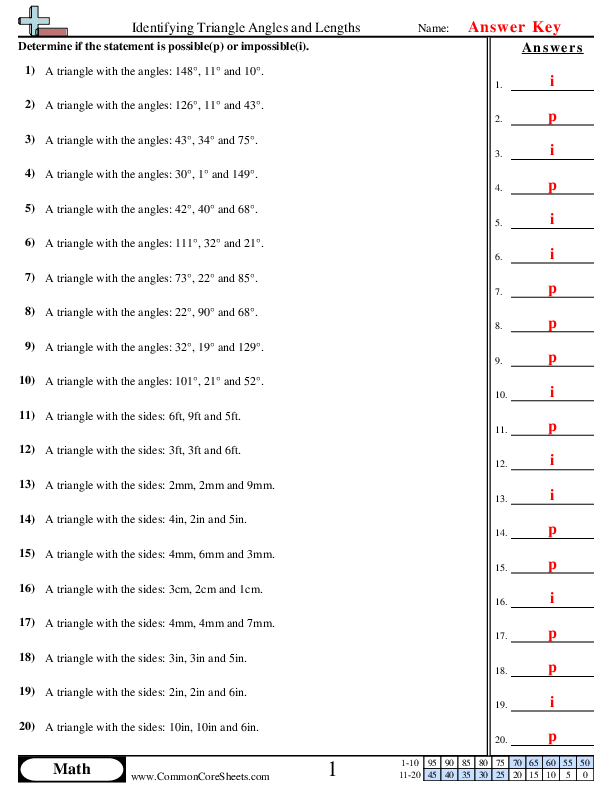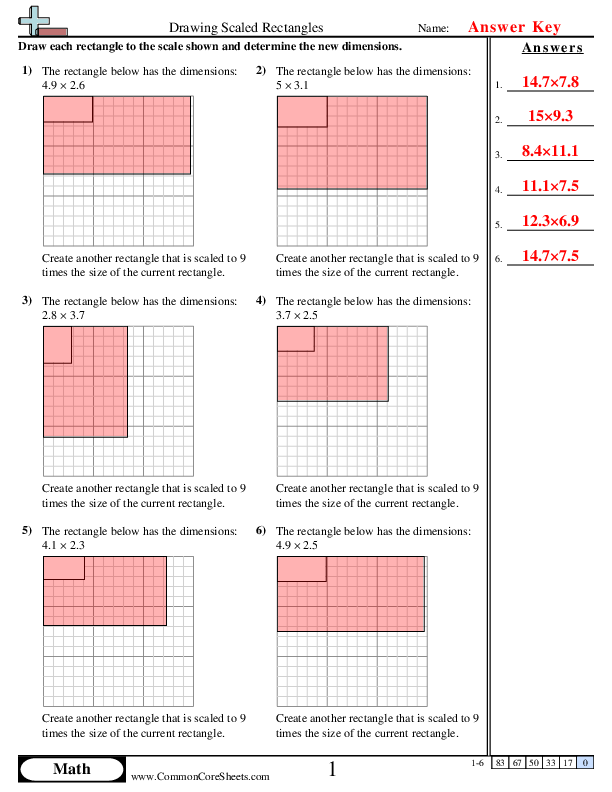Discover the best free shapes worksheets on the internet. Our worksheets help children learn about reflections, translations, the number of sides for everyday shapes and more! We have a wide variety of worksheets that include shapes ranging from basic triangles to complex hexagons and octagons. With our selection, your child can practice recognizing shapes while also learning about their properties. Our worksheets are easy to use and will help your child recognize shapes in a fun environment! With common core sheets, you can be sure you’re giving your child the best learning experience around. Try out our free shapes worksheets today!
Browse Sheets By Problem Type
×

Identifying Triangle Angles and Lengths
7g2


×
Description:
"This worksheet is designed to help children grasp the basics of triangle angles using 20 math problems. Exploring concepts like identifying and adding up angles, this tool is customizable to accommodate individual learning paths. It can be transformed into flashcards for quick revisions or integrated into distance learning curriculum. An engaging approach to mastering triangular geometry."

×
Student Goals:
Deepen Understanding of TrianglesBy completing the worksheet, students will have a thorough understanding of the core geometry concept of triangles, focusing specifically on the relationship between angles and lengths of these shapes.Acquire Problem Solving SkillsWith a set of 20 problems to solve, students get ample opportunity to apply their knowledge, and in the process, sharpen their problem-solving skills. They learn to approach solutions from different angles, improving their analytical thinking.Gain Proficiency in Identifying Triangle AnglesThe worksheet contains problems requiring to identify different angles of a triangle. With constant practice, students will be able to swiftly and accurately identify triangle angles, an essential skill in the study of advanced geometry.Develop Mathematical ConfidenceSolving a variety of problems relating to triangles, students will gain greater conviction in their mathematical abilities. It builds a strong foundation that allows them to tackle more complex mathematical concepts with confidence.Master the Basics of GeometryThe problems on this worksheet pertain to fundamental geometric concepts. Students will be able to fortify their base in geometry by mastering the defining properties of triangles, preparing them for advanced geometric studies.Improve Accuracy and SpeedWith repeated exercise of identifying triangle angles and lengths, students will naturally become quicker and more exact in their calculations, pairing accuracy with speed, which is crucial in timed tests or competitive exams.Enhance Cognitive AbilitiesBy employing multiple skills such as logic, spatial awareness and pattern recognition while identifying triangle angles and lengths, students subconsciously hone their cognitive abilities that are not only critical in math, but across various aspects of education and life.



Slicing 3d Shapes
7g3


×
Description:
"This worksheet is designed to enhance children's understanding of 3D shapes in math through interactive learning. Featuring nine intriguing problems, it explores concepts involving slicing or sectioning 3D shapes. The worksheet is highly customizable, allows for conversion to flashcards, and is compatible for use in distance learning environments. A perfect tool to make math more fun and engaging."

×
Student Goals:
Understanding 3D ShapesAfter completing the worksheet, students should have heightened understanding of the structures and properties of three-dimensional shapes. Their comprehension of geometric fundamentals such as faces, edges, and vertices will be strengthened, which leads to a superior grasp on the spatial aspects in mathematics.Geometrical InsightThe worksheet will enable students to visualize the slicing or partitioning of 3D shapes, enriching their geometrical insight. They should be able to imagine the results of slicing different 3D shapes to understand the formation of new figures and recognize the relationship between the sliced and the original shape.Analytical SkillsThe worksheet aims to foster students' problem-solving and analytical capabilities. Through the practice of various problems, students will learn how to approach different math problems strategically, enhancing their critical thinking and logical reasoning skills.Practical ApplicationThis mathematical knowledge of 3D figures will encourage students to correlate with real-world objects to mathematical depictions. Hence, it will foster an understanding of the practical application of mathematics in the real world, making learning more interactive and fun.Preparation for advanced studiesMastering these fundamentals will lay a strong foundation for students as they progress in their journey of learning mathematics. This knowledge is essential as a preparatory step for future, more complex geometrical concepts including volume, surface area, etc.Boosted ConfidenceSuccessfully solving the problems on the worksheet would increase the confidence levels of the students in their mathematical abilities. This feeling of accomplishment acts as a great motivating factor and encourages further learning.Improvement in Mathematical VocabularyStudents will also learn new mathematical vocabulary and their definitions, for example, parallelepiped, polyhedron, etc. Acquiring such vocabularies is fundamental in understanding mathematical concepts in the future.


Shape Transformations
Link

Drawing Scaled Rectangles
7g1


×
Description:
"This worksheet is designed to guide children in mastering the concept of scale in mathematics by drawing scaled rectangles. It contains six practical problems where students work with dimensions to create rectangles scaled up by different factors. The customizable worksheet is ideal for distance learning, and the content can also be converted into flash cards for convenient learning. It blends problem-solving with creativity, making math fun and engaging."

×
Student Goals:
Understanding of Scaled DimensionsUpon completing the worksheet, students should be able to understand the concept of scaling in geometry. Specifically, they will be able to comprehend how altering one dimension of a rectangle affects the overall scale of the figure. This skill requires a clear understanding of how linear measurements interact with each other in a two-dimensional plane, which is a fundamental aspect of spatial awareness and geometric understanding.Calculation of Size IncreaseStudents will also gain proficiency in calculating size increases. They will be capable of determining how a rectangle's dimensions change when it's scaled up by a specific factor, reinforcing core multiplication skills. The problems pose real-world scenarios that students may encounter in fields that utilize geometry, such as engineering, architecture, or design.Problem Solving and Critical ThinkingBy working through these rectilinear problems, students also exercise their problem solving and critical thinking abilities. They learn to apply their math knowledge to unique settings, challenging them to think creatively and logically. These are essential skills that apply to a wide array of contexts beyond math, helping to prepare students for future academic and professional challenges.Enhanced Mathematical CommunicationAs students determine the scaled rectangles' dimensions, they are expected to communicate their understanding effectively. They can do this by accurately writing or explaining the dimensions of each rectangle. This practice helps deepen their understanding of the mathematical concept and develop their ability to explain mathematical ideas — an important component of comprehensive math literacy.Application and Transfer of SkillsFinally, students will be able to transfer and apply these skills into other areas of mathematics and their daily life. Understanding how to manipulate the sizes of shapes is not just important within the realm of geometry, but also in many practical situations such as reading maps, designing a garden, or coding a video game. Through this worksheet, students are not only able to accomplish a much deeper understanding of geometry, but develop practical life skills as well.




